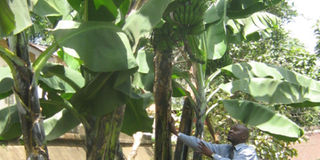Farmers, traders keen on market opportunities for improved bananas

A researcher shows bananas grown from plantlets developed via tissue culture. Modern methods like this will help boost yields, which will lead to better prices and incomes for farmers. FILE PHOTO
What you need to know:
On public expectations from Vitamin A/Iron-enrichment of banana, Nsubuga is optimistic that as farmers and traders in planting materials, they expect high quality.
Stakeholders in Uganda’s banana industry are looking at higher price-fetching bananas, because of their resistance to Banana Bacterial Wilt (BBW) or enrichment with Vitamin A and iron (PVA). The varieties are being developed by scientists at the National Agricultural Research Organisation (Naro).
Leading players say when the National Biotechnology and Biosafety Bill 2012 is passed into law, and these varieties are availed for commercial release, they offer bigger prospects both in selling planting materials, and trade in banana (matooke).
Outcomes
Erostus Nsubuga, chief executive officer, Agro-Genetic Technologies (AGT), and Ben Lubega, an official at Uganda National Farmers’ Federation (UNFFE), say that as key stakeholders they are keenly waiting to partake of the positive attributes of the banana varieties.
Nsubuga explains: “When I add on BBW-resistant lines to the tissue culture ones, I foresee my prospects rising dramatically. For instance, tissue culture provides 30-40 per cent increase in banana and other crop yields. Now when boosted with BBW-resistance and PVA-enrichment, there is no doubt, farmers will be availed better technologies for bigger banana outputs and incomes.”
BBW, which erupted in 2001 in central Uganda, has affected an estimated annual Shs500b income to the farmers and the country. It is also prevalent in the Great Lakes region’s banana-growing belt of N. Tanzania, Rwanda, Burundi and eastern DR Congo.
Assurance
Lubega, who is UNFFE’s chairperson for the central region, says: “Indeed there has been serious damage to bananas by BBW, the worst-hit districts being Mukono and Kayunga, which are under my region. The assurance we get that this BBW-resistant technology will offer us better opportunities against the disease.
However, we need similar assurance that GM banana doesn’t possess any harm to the environment and consumers’ health. That’s our appeal.”
However, Nsubuga—an agricultural scientist—counters that for the time he has followed the anti-BBW research, adequate biosafety measures have been taken.
“Environmental safety was strictly followed, and with the National Biosafety Committee supervising closely, because Uganda is a signatory to the Cartagena Protocol on biosafety that guides member states on how to regulate GM crops.”
Nsubuga recalls that tests to determine the level of resistance to the bacterial disease was also done. “The GM banana variety emerged healthy, inspite of the heavy disease bombardments. So, farmers should rest assured that what is being developed is in their best interest,” he adds.
Expectations
But Lubega also demands that taste and sustained supply of planting materials (suckers) compared to the local breeds that BBW wiped out, are other areas scientists should assure them, before they adopt GM bananas.
“If researchers involve us in their research, by sensitising farmers through the process, then the negative attitudes towards a new technology will be minimised,” he adds.
“We also want to see trials done across all agro-ecological zones of Uganda, for the public to witness field performance against BBW. Farmers are asking, when you introduce such technology, what are its impacts on the other bananas?”
On public expectations from Vitamin A/Iron-enrichment of banana, Nsubuga is optimistic that as farmers and traders in planting materials, they expect high quality.
No threats
Nsubuga, who chairs Uganda Biotechnology and Biosafety Consortium, a multi-interest groups’ unifying body, points out that his company, AGT currently produces up to 1.5 million banana plantlets and 300,000-500,000 coffee plantlets.
“In general, we produce close to five million tissue culture banana and coffee plantlets annually, depending on the orders. When BBW-resistant and PVA bananas are available, the demand for plantlets will certainly rise. We shall witness a boost in output in both tissue culture facilities and farmers’ plantations.”
In Uganda, farmers with better-yielding banana varieties sell suckers to others under a growing trend as a lucrative business.
Although modern biotechnology is also applied in medical and pharmaceutical industries, its use and application in agricultural sector has remained a subject of controversy worldwide.
While there are compelling arguments for each side, there are no known scientific evidences that indicate GM crops have posed safety threats to human health and environment.




